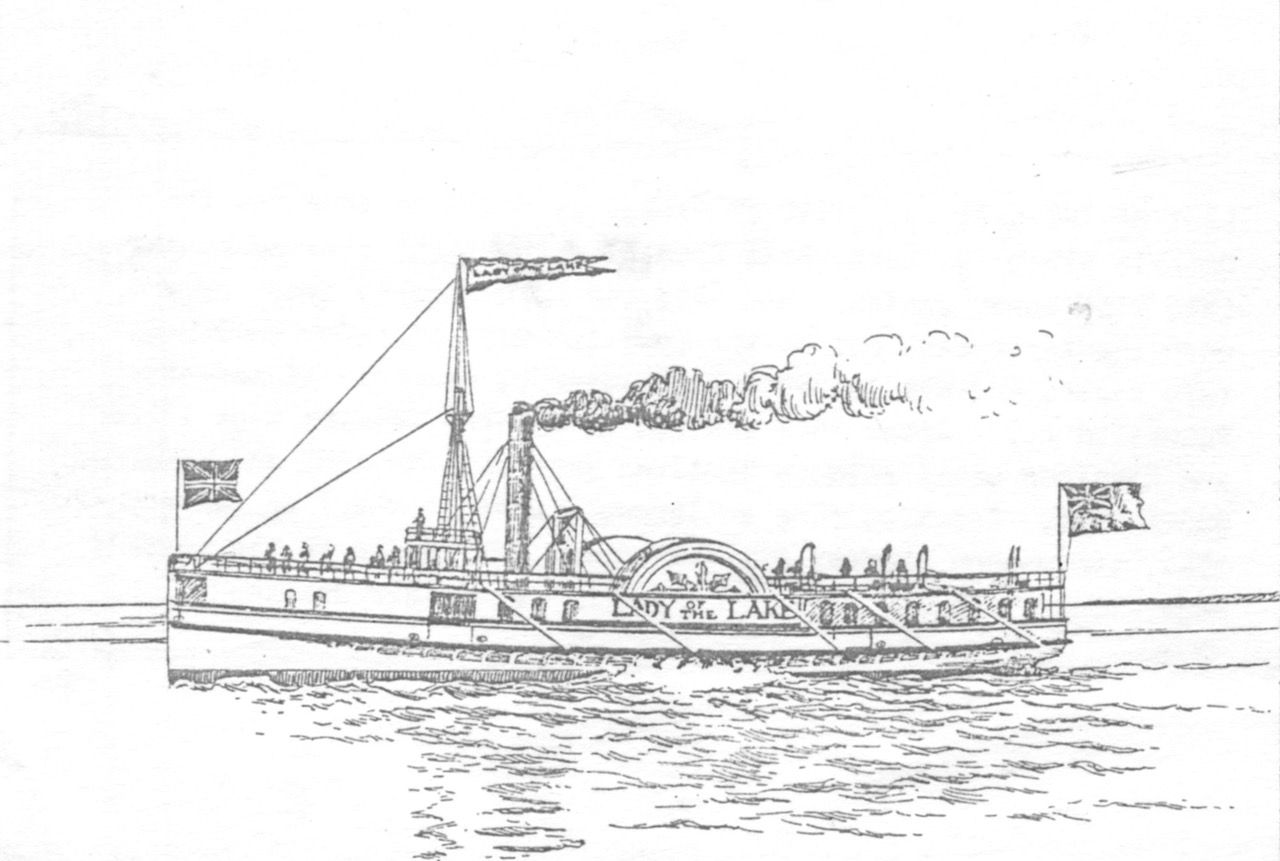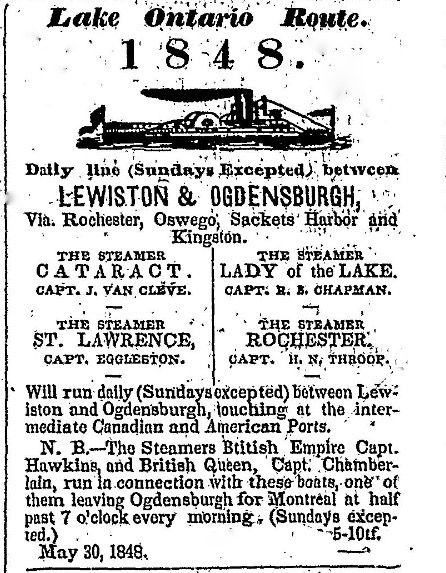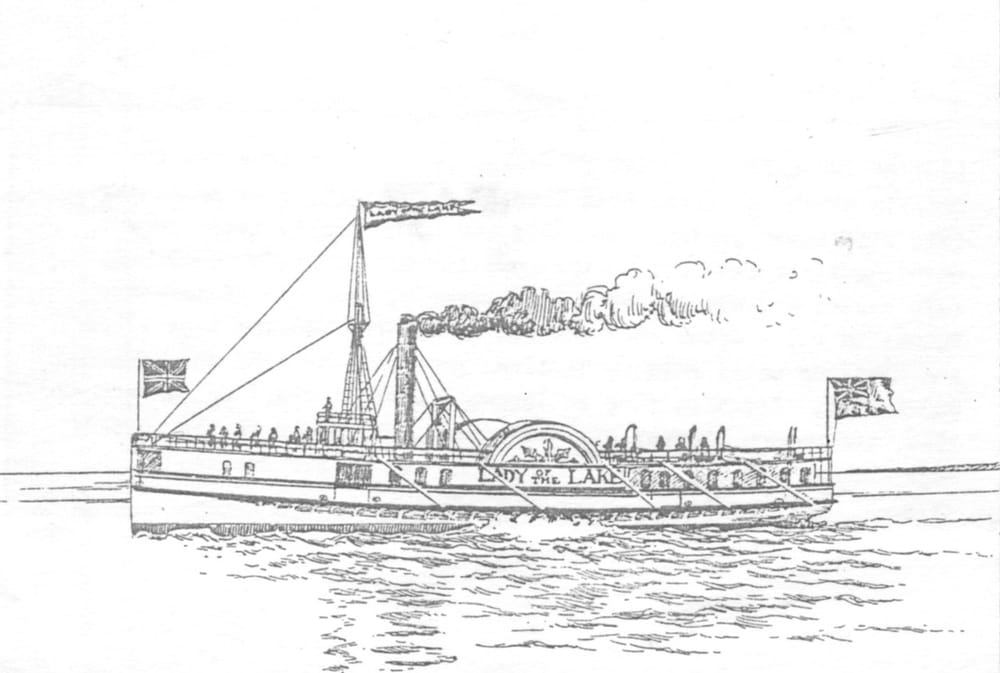Steamboat Lady of the Lake Sailed Lake Ontario and the St. Lawrence River
by: Richard Palmer
One of the most popular steamboats on Lake Ontario and the St. Lawrence River in the 19th century was the Lady of the Lake, of the Ontario & St. Lawrence Steamboat Company. She was launched from the shipyard of George S. Weeks in Oswego on April 28, 1842. The keel had been laid the previous December. It was described as “the best steam vessel which floats on our lake.” At that time, steamboat travel on inland waterways was at its zenith.
About 300 people went on Lady of the Lake’s initial shake-down trip that June, from Oswego to Ogdensburg, a distance of 140 miles, commanded by Captain John J. Taylor. The trip took 11 hours, which included three stops, or a running time of eight hours, in what were described as rough seas.

The Lady of the Lake proved to be a very popular boat. She had a spacious promenade deck, state rooms, and a dining hall. Built at a cost of $50,000 for the Ontario & St. Lawrence Steamboat Company, she was 197 feet long, 24 feet wide, and was equipped with a 100-horsepower low pressure crosshead engine, which was built at the Allaire Works in New York and shipped to Oswego. She replaced the steamboat United States, which was built in Ogdensburg in 1831 and dismantled in Oswego in 1843.
The Ontario & St. Lawrence Steamboat Company, which was incorporated on January 28, 1831, owned and operated a fleet of steamboats on the U. S. side of Lake Ontario and the St. Lawrence River.
These ships included:
Lake Steamers
• Side-wheeler Bay State built at Clayton, NY, 1848. Renamed Athenian
• Side-wheeler Cataract built at Clayton, NY, 1846. Renamed Columbian
• Side-wheeler George Clinton built at Oswego, NY, 1842
• Side-wheeler Niagara built at Clayton, NY, 1845. Renamed U.S. Army Transport Suffolk during the Civil War.
• Side-wheeler Oneida built at Pultneyville, NY, 1835
• Side-wheeler Rochester built at Oswego, NY, 1842
• Side-wheeler St. Lawrence built at Oswego, NY, 1839
• Side-wheeler United States built Ogdensburg (Oswegatchie), NY, 1832
• Propeller Mithune built 1850. Renamed Northerner 1854
River Steamers operated in conjunction with O.& St. L. Steamboat Co.
• Side-wheeler British Empire built at Port Metcalfe, Wolfe Island, ON, 1845
• Side-wheeler British Queen built at Port Metcalfe, Wolfe Island, ON, 1845
• Side-wheeler Jenny Lind built at Montréal, QC, 1850
The Lady of the Lake was the first steamboat on Lake Ontario and the St. Lawrence River with an upper cabin. She was registered at 422 tons and could accommodate about 50 cabin passengers. Her regular route was between Lewiston, NY, and Ogdensburg, NY, stopping at various ports including Oswego and Sackets Harbor in New York, and Kingston and Brockville in Ontario.
It wasn’t always smooth sailing for these vessels though, particularly in the late fall. The Oswego Palladium of Nov. 14, 1842 reported:
“On the evening of the 13th there was a violent squall on Lake Ontario, accompanied as those who were on the lake say, by snow and lightning. The Lady of the Lake, Capt. John Taylor, was on her passage from Sackets Harbor to this port and encountered the utmost violence of the squall. It lasted but two or three hours, but as the weather was bad for a day or two previous, there soon arose a tremendous sea. Considerable anxiety was felt, as the snowstorm precluded all view of objects the boat's length off, and she was known to be on her way. She safely arrived – reporting the extraordinary occurrence of a violent snow squall accompanied by excessive lightning. It was merely the return of the 13th of November, and of the meteoric showers, which now seem to belong to our system and annually visit us at about that period of the year.” Competition was keen and it was the custom in those days for impromptu races to prove the mettle of competing steamboats. In one such race, the Canadian steamer Eclipse challenged the Lady of the Lake in a trial of speed between Niagara and Toronto, a distance of 40 miles. On one fine August day in 1843, the Eclipse beat the Lady of the Lake by four and a half minutes.

Lady of the Lake led a relatively uneventful life sailing Lake Ontario and the St. Lawrence River. Other captains over the years included J. H. Hoag and D. Eggleston. In 1852, she operated as a ferry between Cape Vincent, NY, and Kingston, ON. In July 1854, the ship was sold to Mr. M.W. Brown of Hamilton and renamed Queen City. Less than a year later, on January 21, 1855, the ship caught fire and burned to the water’s edge at the Queen’s Wharf in Toronto. The Constitutional, a newspaper in St. Catharines, ON, tells the story:
“About 9 o'clock last evening, the steamer Queen City was lying at the Queen's Wharf flames were discovered proceeding from the engine room. The captain and crew were all on board, but they speedily ascertained that all their efforts to extinguish the fire would be unavailing; and they turned their attention to saving the cargo. The steamers Chief Justice Robinson, and Welland were moored astern to the Queen, and were for some time in imminent danger; but, as quickly as possible, they were cut loose and were moved to a place of greater safety. The flames continued to spread and even extended to the wharf, so as to cause some alarm for the safety of the Peerless, Mayflower, and some schooners moored off the other side; which, after some delay, the Queen was shoved off and suffered to drift to the eastward, where she came to contact with the ice opposite the wharf of the Northern Rail Road Company, and then burned to the water's edge."
The Queen City was owned by Mr. M.W. Browne, of Hamilton, having been purchased by him last year for the Hamilton route. She was worth about £4,000 and is said to be fully insured. She had about ten tons of goods on board, for the ports between this place and Hamilton, chiefly consisting of dry goods and groceries, only a small part of which was saved.
The Queen City was built at Oswego about thirteen years ago and was then known as the Lady Of The Lake, one of the crack boats on the waters, the honors being about equally divided between her and the Eclipse. Vessels of improved character have since been introduced, and the Lady fell gradually so low as to ply as a ferry boat from Cape Vincent to Kingston. She then fell into the hands of Mr. Browne, who ran her with considerable success, notwithstanding her age, between Hamilton and Niagara. There is no reason to doubt that the fire was entirely the work of accident. It probably having originated among the wood in the engine room.”
The sad ending for a popular steamboat came on March 14 when the engine, machinery, and equipment were sold at public auction. The remains were scrapped.
By Richard Palmer
Richard F. Palmer is a retired newspaper editor and reporter, and he was well known for his weekly historical columns for the “Oswego Palladium-Times,” called "On the Waterfront." His first article for TI Life was written in January 2015, and since then, he has written a dozen-plus others. He is a voracious researcher, and TI Life readers benefit from his interesting findings. Click here to see some of Richard Palmer’s TI Life Articles.
Sources
• Great Lakes Maritime Database, Alpena Public Library
• Gerald C. Metzler Great Lakes Database, Wisconsin Maritime Museum
• Historical Collections of the Great Lakes, website at Bowling Green State
• University Various newspapers (cited in article)• Van Cleve, James, “Reminiscences of Early Steamboats, Propellers and Sailing Vessels on Lake Ontario and River St. Lawrence," an unpublished manuscript by James Van Cleve, Lewiston, NY, 1877, p 145. Copy in Oswego City Hall.






Please click here if you are unable to post your comment.